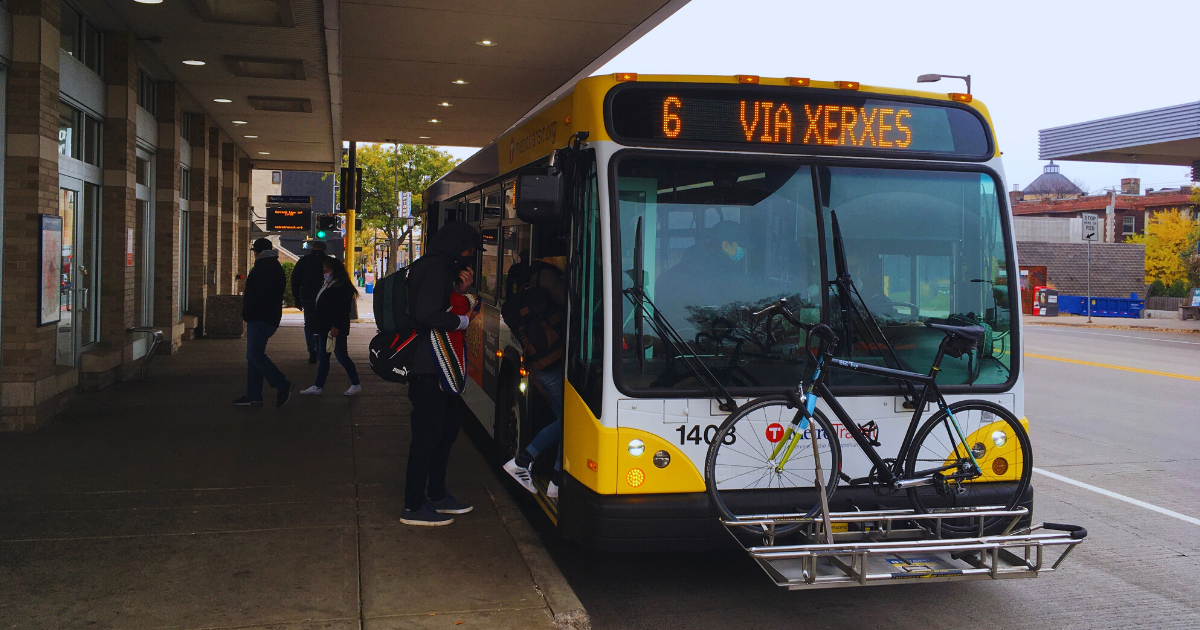Bus Lanes and Signal Priority for Better, Faster Transit in the Twin Cities
Almost every Twin Cities transit rider has been there: that mix of appreciation that the bus is getting you where you need to go, and the feeling that it just shouldn’t take so long. And we’re all right. It shouldn’t—and it doesn’t have to be this way.
Right now, even the Twin Cities’ busiest bus lines aren’t serving people like they should. For some, a long, slow bus ride is a hassle. For others it is truly a barrier. Many metro residents can’t access jobs, housing, healthcare, childcare, or education because our buses are too slow. At the same time, due to how much people have to drive, Minnesota’s transportation system is a major source of pollution: the kind fueling the climate crisis and the kind creating dirty air that makes people sick, especially in marginalized communities.
To protect our air and climate and to improve access and connection our communities, the Twin Cities needs better, faster bus rides for more people. To make it happen, we need dedicated bus lanes and bus signal priority on the metro’s most-used transit routes. These are simple and inexpensive fixes with the power to make a big impact.
Why Bus Lanes and Signal Priority?
Since Move Minnesota launched our Boost the Bus campaign last fall, our staff and volunteer working group have been exploring multiple ways to improve transit trips in the metro. We started by looking at the core of our bus system, Metro Transit’s High Frequency Network. Through conversations and research, our Boost the Bus team identified signal priority and dedicated bus lanes as critical first steps to improving these routes, which are among our cities’ most used.
Bus riders shouldn’t have to wait years for progress to come one new line at a time—we need system-wide improvements now. Adding bus lanes and signal priority would immediately make transit trips faster and more reliable, and we can easily make these upgrades all across our metro’s High Frequency Network. With transit signal priority, red and green light cycles are adjusted to move buses faster by either shortening a red light when a bus is at an intersection or holding a green light longer. Dedicated lanes ensure buses—and bus riders!—don’t waste time stuck in car traffic; often painted onto the street, these simple markings provide designated space for your bus to move efficiently along its route and get you to your destination more quickly.
Quick, reliable bus service is a justice issue and a climate issue. Bus lanes and signal priority will improve access to jobs, opportunity, clean air, and essential resources for all—in particular people of color, people with disabilities, youth, seniors, and people with low incomes. Improving transit will significantly reduce carbon emissions from transportation.
- 40% of transit riders in Minnesota are essential workers
- 44% of riders are Black, Indigenous, or people of color
- 47% of riders don’t have access to a vehicle
- 94% of jobs in the metro are not accessible to transit riders in under 45 minutes
- 27% of Minnesota’s carbon emissions come from the transportation sector
Bus lanes and signal priority can significantly speed up transit trips. Cities across the country have successfully implemented signal priority and dedicated bus lanes and delivered substantial time savings. When used in combination, signal priority and dedicated bus lanes can improve Twin Cities transit travel times by more than 20%, transforming our bus system and the experience of everyone who rides it:
- Estimated time savings of more than 40 hours per year per person.
- 780,850 hours saved across total ridership per year—at $15 per hour, that’s more than $11 million.
- More frequent buses and shorter transfers (assuming no reduction in the number of buses per route).
These lasting improvements are very cost-effective. Providing transit signal priority across all High Frequency Network lines would cost only $4 million. Painting bus lanes on half the lane miles of these routes would cost only $5 million. This is a small price to pay for ensuring transit can effectively serve people who already rely on it, and to provide the quality service we need to keep growing ridership.
Getting Decision-Makers on Board
Metro Transit can’t make these changes alone: they need available funding, as well as the cooperation of cities, counties, and the Metropolitan Council.
This spring, Move Minnesota and our Boost the Bus volunteers are already organizing conversations with Hennepin and Ramsey County commissioners to advocate for these improvements. Counties play an especially important role in the build out and maintenance of our regional transit system. Hennepin and Ramsey Counties has the power to reduce racial disparities, increase economic justice, and lower climate pollution by funding and implementing transit signal priority across all intersections on the High Frequency Network and bus lanes on the most congested 50% of the network.
We need your help to get decision-makers on board! Get involved at an upcoming meeting in your district:
- May 17 with Hennepin County District 1 Commissioner Jeff Lunde
- May 19 with Hennepin County District 3 Commissioner Marion Greene
- May 28 with Ramsey County District 3 Commissioner Trista MastasCastillo
- June 16 with Hennepin County District 2 Commissioner Irene Fernando
These meetings will be hosted online—with more to come! Check out our events calendar for a full list.

